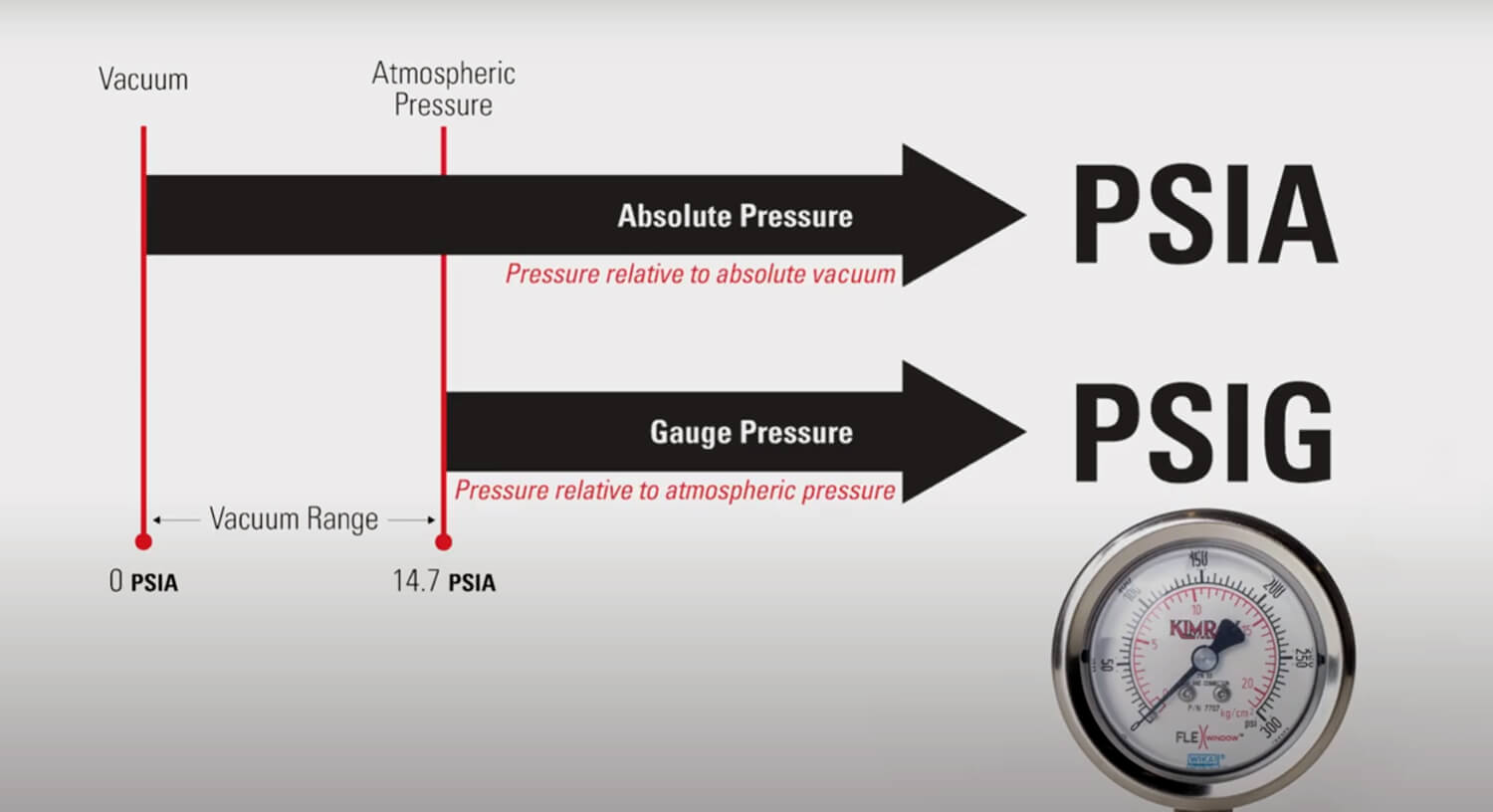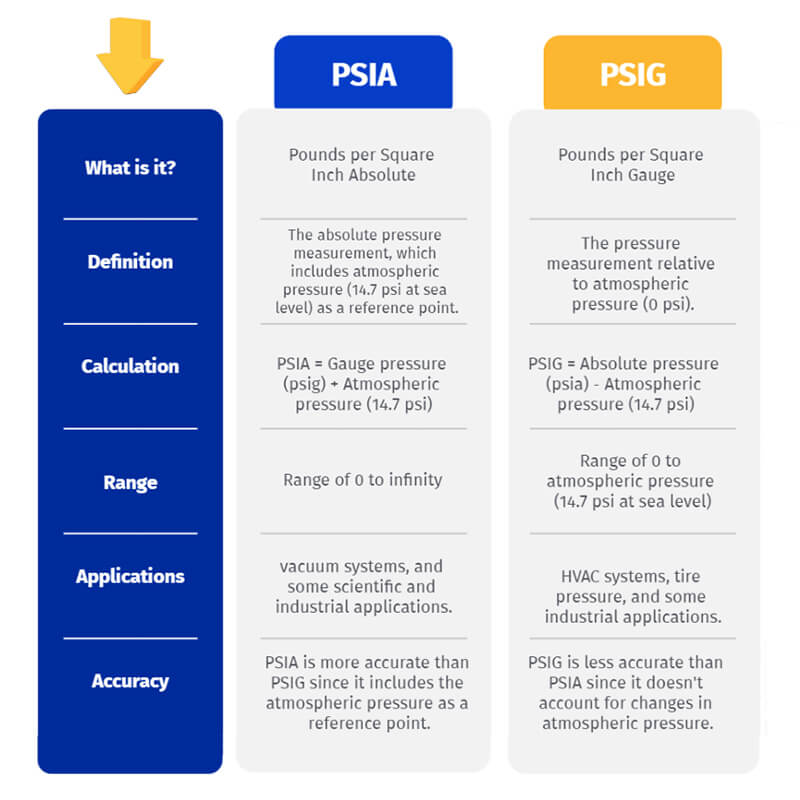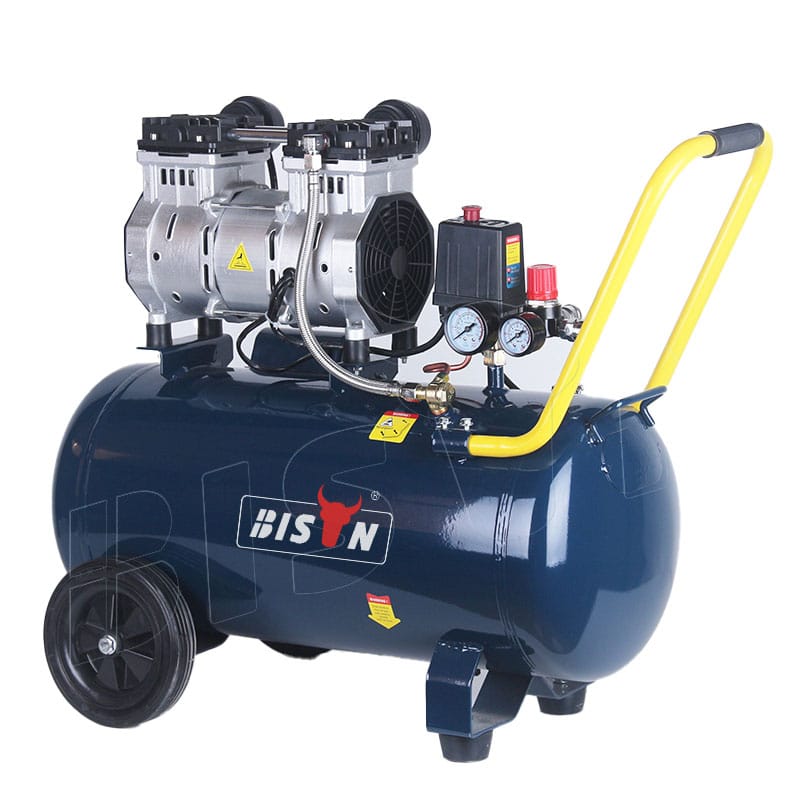air compressor blog
PSIA vs PSIG vs PSI | Understanding Air Compressor Pressure
- Apr 4, 2023
You’ve heard the term PSI, one of the most commonly used pressure measurement units. PSI is used across industries and applications to describe and evaluate the amount of force something exerts. Take tire pressure PSI as an example. When you pump air into a tire, molecules bounce around inside, putting pressure on the inside; this pressure is your tire’s air pressure. However, regarding air compressor measurements, PSI has a slightly different meaning.
Compressed air measurement: PSI
PSI indicates the maximum pressure an air compressor can produce and, along with CFM (cubic feet per minute), is a critical measurement of compressor performance. Remember that your altitude and geographic location can affect air pressure measurements, so we recommend consulting BISON’s air compressor experts when specifying a compressor for your business. There are three different ways to view PSI:
- PSI which stands for pounds per square inch, measures the air force delivered by an air compressor. For example, a compressor is rated at 125 psi, providing 125 pounds per square inch of pressure.
- PSIA is absolute pounds per square inch. Sometimes known as total pressure, PSIA refers to pressure relative to zero or a perfect vacuum.
- PSIG is Pounds per square gauge, which is a pressure measurement measured relative to ambient atmospheric pressure.

What is the difference between PSIA, PSIG and PSI?
From the above discussion, we can explain the critical differences between them as follows:
PSI refers to the amount of force exerted on an object with an area of one square inch.
PSIG or pounds per square inch, gauge is a unit of pressure relative to the surrounding atmospheric pressure, the “g” in psig indicates that it is a relative measurement. PSIG expresses the pressure value, that is, the gas pressure in a system relative to the external atmospheric pressure.
PSIA is a unit of pressure measurement in the imperial system relative to absolute zero or full vacuum pressure (0 PSI). PSIA is the abbreviation of absolute pressure, which includes not only the pressure of the gas itself in the system, but also the atmospheric pressure.
DO PSI And PSIG Mean The Same Thing?
When discussing the size of air pressure units, it is common to see PSIG used as the default representation. For example, tire pressure is gauge pressure, which is measured in PSI. As for P&ID, a professional term in the field of industrial drawings, if it uses PSIA as the unit, we need to convert it to PSIG in order to appropriately adjust the size of the valve or control device. This conversion process is not complicated, but it is crucial to ensure the accuracy and safety of system operation.
It is worth noting that although PSIG and PSIA are both air pressure units used to describe pressure values, there are differences between them. PSIG refers to the expression of gas pressure at relative zero; PSIA is an absolute pressure standard based on ambient temperature. Considering that different temperature conditions may occur in actual application scenarios, it is important to understand which pressure unit is more appropriate before performing conversion calculations.
All in all, understanding and mastering the common sense and skills of air pressure units is one of the essential qualities for every mechanical engineer. I hope this article can help you gain a deeper understanding of various pressure units, improve work efficiency and ensure the normal operation of the system.
PSIA is always greater than PSIG
PSIA means total pressure, while PSIG means pressure relative to the atmospheric pressure at that location. If data for the exact location is unavailable, sea-level atmospheric pressure (14.7 PSIA) can be used.
PSIA does not vary with altitude, but PSIG does because fewer air molecules are present at higher altitudes to create pressure.
PSIA can never be negative, on the other hand PSIG can be negative. The vacuum pressure in the subatmospheric PSIG is negative.
Example of how PSIG and PSIA are calculated
PSIG is always lower than PSIA. The formulas describing this relationship are:
PSIG + 1 atm = PSIA
hence
PSIA – 1 atm = PSIG (where atm is simply atmospheric pressure).
Calculating PSIA or PSIG or converting between the two is easy. If available, you can use the actual barometric pressure value for your location, or you can convert PSIG to PSIA and vice versa using 14.7 psi (approximate barometric pressure at sea level) as a standard value. (Unless you live at a high altitude or in a deep location, the sea level value comes into play.)
In other words, since the sea level atmospheric pressure is 14.7 PSIA, you subtract the PSIA of 14.7 from the atmospheric pressure of 14.7 equals zero PSIG (14.7 (PSIA) – 14.7 (atm) = 0).
For example, the absolute pressure is 14.70 PSIA at sea level and 14.18 PSIA at an altitude of 1,000 feet. At higher altitudes, the pressure is smaller, so if an absolute gauge is read at 1000 feet, it will read almost 0.5 PSI less than a standard gauge (14.70 – 14.18 = .52).

What are the applications of PSI and PSIG?
The more commonly used gauge in the air compressor industry is pounds per square inch. Gauge pressure is sometimes used to ignore the effects of weather, depth and altitude changes. This reference measures pressure relative to atmospheric pressure. Tire pressure is often measured in psi and other testing and measurement activities.
PSI units are available as non-SI units of measure for industrial applications such as fuel distribution and storage, wastewater management, and more. When the gauge reads ten psig, the actual pressure on the gauge will be 24.7 psia, which is the psig reading plus the barometric reading
The influence on the air pressure of the air compressor
The air pressure of an air compressor is a key factor in determining its efficiency and effectiveness, affecting the performance of the tools and machinery on which it is used. However, the air pressure of the compressor can be affected by a variety of factors, including altitude and temperature.
Altitude means altitude above sea level. As altitude increases, air pressure decreases. Therefore, if the air compressor is used at high altitudes, its air pressure output will be lower than when it is used at low altitudes. In other words, if your main market is in high altitude areas, then you should choose an air compressor with a larger PSI.
Temperature is another factor that affects the air pressure of an air compressor. As the temperature of the air inside the compressor increases, the air molecules become more active and move faster, causing the air pressure to increase. Conversely, when the temperature decreases, the air pressure also decreases.
PSI, PSIA or PSIG: Which should you use?
You now know the difference between PSI, PSIA, and PSIG, you can choose the best air compressor for your business.
BISON’s knowledgeable technicians can answer any questions about air compressor PSI, PSIA, PSIG or pressure measurement.
Please note that BISON air compressor manufacturer & supplier recommends that you keep in mind that altitude and geographical location will directly affect the measurement of air pressure. Therefore, when selecting an air compressor for your specific application and process, we strongly recommend that you consult your local air compression expert or contact BISON air compressor specialists for more accurate advice and support.
frequently asked questions about PSIA vs PSIG vs PSI | Understanding Air Compressor Pressure
Is 0 PSI a vacuum?
A vacuum is defined as a partially depleted space. Vacuum pressure is calculated and measured relative to ambient atmospheric pressure. Typically, air pumps draw air from confined spaces, creating a vacuum. We learn that 1 atmosphere of pressure is approximately 14.7 PSIA. Therefore, if the atmosphere is removed from space, the pressure will drop below 14.7 PSIA, and a vacuum will begin to be created. Once all the air is expelled from the confined space, it will reach 0 PSIA, a complete vacuum.
What does PSIA stand for?
PSIA stands for pounds per square inch absolute. This is the measurable pressure relative to a perfect vacuum. Measurements are often imprecise due to atmospheric, gauge, or non-absolute pressure variations, whereas absolute pressure is always determined.
If you have any enquiries about the BISON air compressor, we would love to hear from you.







